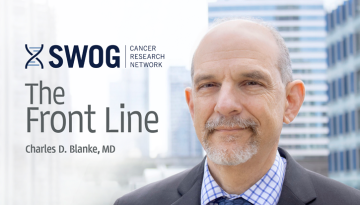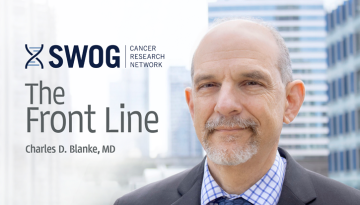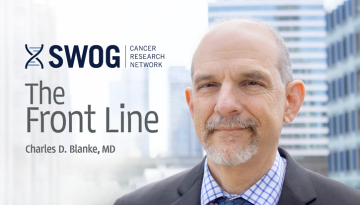SWOG Shares Critical Additional Data on PCPT
This year marks the 25th anniversary of the launch of the Prostate Cancer Prevention Trial, one of SWOG’s biggest and best.
Led by Dr. Ian Thompson, the PCPT enrolled and randomized 18,882 men. It has gone on to spawn 148 published manuscripts and 33 published conference abstracts, and fed 27 other research projects with data or biological samples – or both. It also contributed to seven consortia projects.
Now the trial, Dr. Thompson, and his team have delivered again. Last Saturday, at the 2018 Annual American Urological Association Meeting in San Francisco, Thompson announced final, long-term follow-up results. Finasteride clearly reduces men's risk of getting prostate cancer without increasing their risk of dying from the disease. Initial study findings suggested there may be a link between use of the drug and a more lethal form of prostate cancer, but long-term follow-up shows that is not true.
Thompson and his team, led by Phyllis Goodman at the statistics and data management center, went back to the PCPT and matched participants to the National Death Index, a centralized database of death record information managed by the U.S. Centers for Disease Control and Prevention. This analysis allowed the SWOG team to determine if a trial participant had died and to determine the cause of death. With almost 300,000 person-years of follow-up and a median follow-up of 18.4 years, they found 42 deaths due to prostate cancer on the finasteride arm and 56 on placebo. Thus, there was no statistically significant increased risk of prostate cancer death with finasteride.
In our press release on the AUA lecture, Thompson said: “This discovery could benefit tens of thousands of men each year in the United States by identifying a drug that can safely and effectively prevent prostate cancer. Treatment for the disease is costly and can have serious side effects, such as impotence and urinary incontinence. My hope is that the visionary decision of our National Cancer Institute colleagues to conduct this study, and the scientific evidence it produced these last 25 years, will provide a lasting benefit for patients.”
Now that we know finasteride provides benefits, and no lasting negative effects, the big questions are: Will doctors prescribe it – and will men take it? My unsatisfying answer: Both remain to be seen.
Also, the prostate cancer screening and prevention landscape is shifting – again. After a surge in PSA blood testing – and a resulting surge in the number of low-risk cancers found and treated at a high physical and financial cost to patients – the US Preventive Services Task Force (USPSTF) in 2012 downgraded such testing to a “D” rating, which means “there is moderate or high certainty that the service has no net benefit or that the harms outweigh the benefits." Screening plummeted as a result. This month, the USPSTF bumped up their grade to a C, suggesting a softer and more nuanced risk-versus-harm conversation between physicians and their patients.
Dr. Thompson details this pendulum swing this week in an editorial in Cancer, and calls for more large-scale, long-term trials – like the PCPT – that would guide clinical practice when it comes to prostate cancer prevention, detection, and care.
He writes: “We are at the crossroads yet again in the control of the most common tumor among American men: we can lurch back and forth with the pendulum of public policy toward early detection, using our precious health care resources in an unproven manner, or we can assemble our best scientists to plan the next generation of early detection trials, allowing generations to come to reap their benefits.”
Hopefully, much of the next generation of trials will start here at SWOG.
Other Recent Stories



